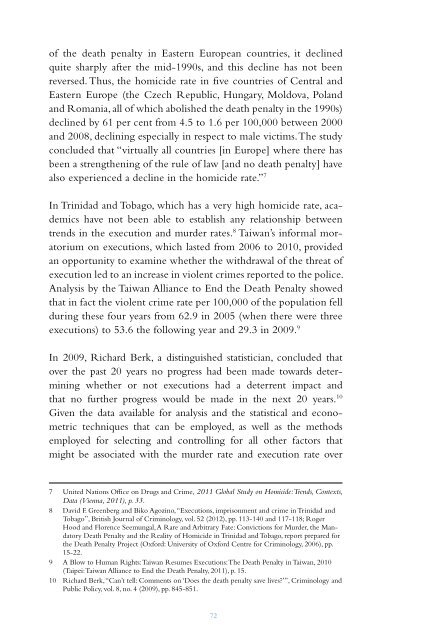PENALTY
DBk0302s7Xm
DBk0302s7Xm
You also want an ePaper? Increase the reach of your titles
YUMPU automatically turns print PDFs into web optimized ePapers that Google loves.
of the death penalty in Eastern European countries, it declined<br />
quite sharply after the mid-1990s, and this decline has not been<br />
reversed. Thus, the homicide rate in five countries of Central and<br />
Eastern Europe (the Czech Republic, Hungary, Moldova, Poland<br />
and Romania, all of which abolished the death penalty in the 1990s)<br />
declined by 61 per cent from 4.5 to 1.6 per 100,000 between 2000<br />
and 2008, declining especially in respect to male victims. The study<br />
concluded that “virtually all countries [in Europe] where there has<br />
been a strengthening of the rule of law [and no death penalty] have<br />
also experienced a decline in the homicide rate.” 7<br />
In Trinidad and Tobago, which has a very high homicide rate, academics<br />
have not been able to establish any relationship between<br />
trends in the execution and murder rates. 8 Taiwan’s informal moratorium<br />
on executions, which lasted from 2006 to 2010, provided<br />
an opportunity to examine whether the withdrawal of the threat of<br />
execution led to an increase in violent crimes reported to the police.<br />
Analysis by the Taiwan Alliance to End the Death Penalty showed<br />
that in fact the violent crime rate per 100,000 of the population fell<br />
during these four years from 62.9 in 2005 (when there were three<br />
executions) to 53.6 the following year and 29.3 in 2009. 9<br />
In 2009, Richard Berk, a distinguished statistician, concluded that<br />
over the past 20 years no progress had been made towards determining<br />
whether or not executions had a deterrent impact and<br />
that no further progress would be made in the next 20 years. 10<br />
Given the data available for analysis and the statistical and econometric<br />
techniques that can be employed, as well as the methods<br />
employed for selecting and controlling for all other factors that<br />
might be associated with the murder rate and execution rate over<br />
7 United Nations Office on Drugs and Crime, 2011 Global Study on Homicide: Trends, Contexts,<br />
Data (Vienna, 2011), p. 33.<br />
8 David F. Greenberg and Biko Agozino, “Executions, imprisonment and crime in Trinidad and<br />
Tobago”, British Journal of Criminology, vol. 52 (2012), pp. 113-140 and 117-118; Roger<br />
Hood and Florence Seemungal, A Rare and Arbitrary Fate: Convictions for Murder, the Mandatory<br />
Death Penalty and the Reality of Homicide in Trinidad and Tobago, report prepared for<br />
the Death Penalty Project (Oxford: University of Oxford Centre for Criminology, 2006), pp.<br />
15-22.<br />
9 A Blow to Human Rights: Taiwan Resumes Executions: The Death Penalty in Taiwan, 2010<br />
(Taipei: Taiwan Alliance to End the Death Penalty, 2011), p. 15.<br />
10 Richard Berk, “Can’t tell: Comments on ‘Does the death penalty save lives?’”, Criminology and<br />
Public Policy, vol. 8, no. 4 (2009), pp. 845-851.<br />
time and across jurisdictions, contradictory findings and interpretations<br />
seem to be inevitable. 11 Articles in the Journal of Quantitative<br />
Criminology, published in 2013, came to similar conclusions, making<br />
clear that the recent literature on deterrence in the United States<br />
was “inconclusive as a whole, and in many cases uninformative”, 12<br />
primarily because of methodological problems. As another article<br />
in the journal concluded: “It is thus immaterial whether the studies<br />
purport to find evidence in favour or against deterrence. They<br />
simply do not rise to level of credible evidence on deterrence as a<br />
behavioural mechanism.” 13<br />
Although there must have been instances in which people refrained<br />
from murder out of fear of execution, this in itself is an insufficient<br />
basis on which to conclude that the existence of the death penalty<br />
and the (often remote) threat of execution will lead to a lower<br />
rate of murder than would be the case without it. The issue is not<br />
whether the death penalty deters some (if only a few) people where<br />
the threat of a lesser punishment would not, but whether, when<br />
all the circumstances surrounding its use are taken into account,<br />
it is associated with a marginally lower rate of the death-penaltyeligible<br />
kinds of murder than the next most severe penalty,<br />
life imprisonment.<br />
The reason one must weigh all its effects is that capital punishment<br />
has several drawbacks to counter its supposedly obvious advantages.<br />
For example, offenders threatened with death could have an added<br />
incentive to kill witnesses to their crimes. Furthermore, it may be<br />
much less easy to convict people when the punishment may be death<br />
than when it is less draconian. In other words, severity of punishment<br />
may run counter to the more effective certainty of punishment.<br />
Evidence to support this comes from England, Wales and Canada,<br />
11 See Ethan Cohen-Cole, Jeffrey Fagan and Daniel Nagin, “Model uncertainty and the deterrent<br />
effect of capital punishment”, American Law and Economics Review, vol. 7, no. 2 (2008), pp.<br />
335-369. These authors used a model-averaging method across different studies and concluded,<br />
“not that there is no deterrent effect present, but rather that inferences on its magnitude are so<br />
imprecise as to make representation of strong claims impossible” (p. 364).<br />
12 Aaron Chalfin, Amelia M. Haviland and Steven Raphael, “What do panel studies tell us about<br />
a deterrent effect of capital punishment? A critique of the literature”, Journal of Quantitative<br />
Criminology, vol. 29 (2013), pp. 5-43, at pp. 5 and 8.<br />
13 Kerwin Kofi Charles and Steven N. Durlauf, “Pitfalls in the use of time series methods to study<br />
deterrence and capital punishment”, Journal of Quantitative Criminology, vol. 29 (2013), pp.<br />
45-66, at pp. 45-46 and 65.<br />
72 73


